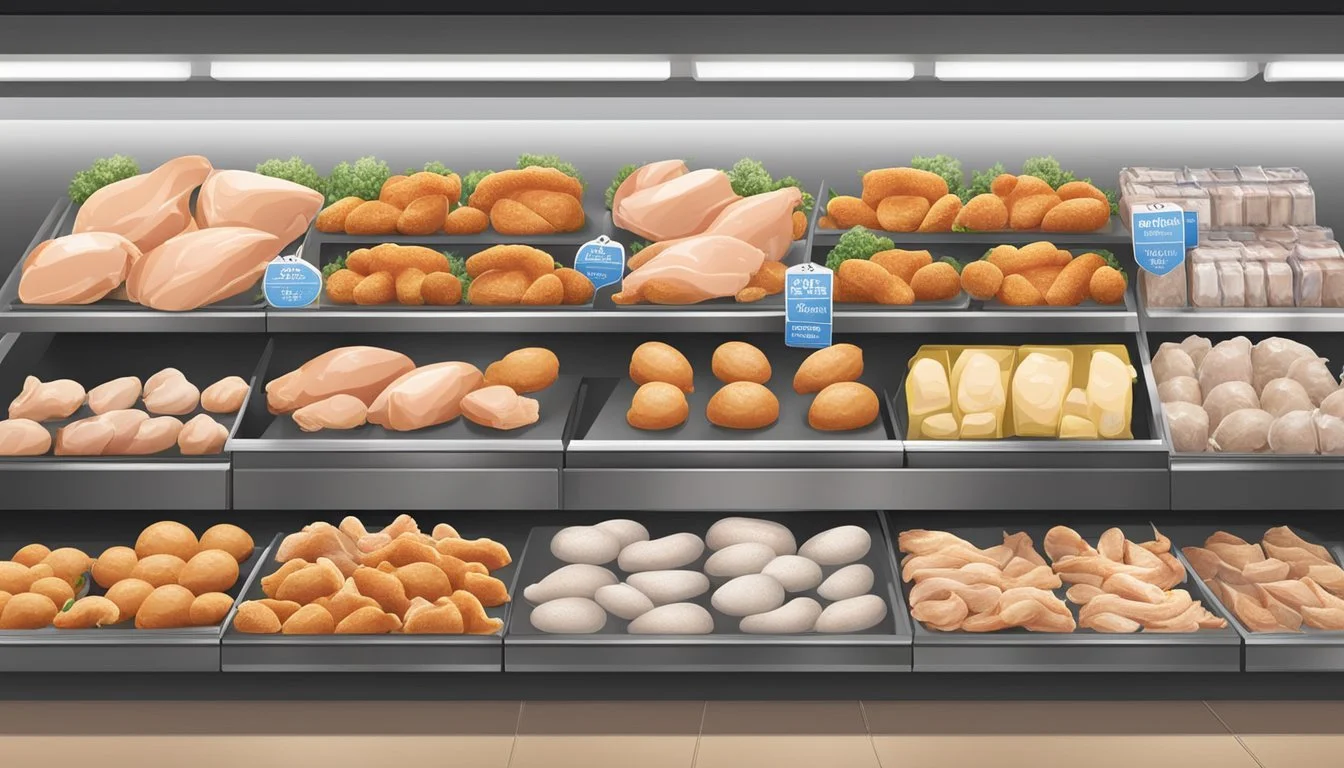Poultry Perfection: Uncovering the Top Grocery Stores for Premium Chicken Breasts
Choosing the best grocery store for chicken breast can significantly impact the quality and taste of your meals. When it comes to poultry, freshness and sourcing are paramount. Publix stands out as a top choice for chicken breast, offering consistently high-quality options at reasonable prices.
Many consumers prioritize organic and antibiotic-free chicken. Whole Foods Market excels in this category, providing a wide selection of organic and ethically sourced poultry. Their chicken breasts tend to be fresh, with tight skin and a pale pink hue indicative of quality.
For those seeking a balance between quality and affordability, Costco offers excellent value. Their chicken breasts are often competitively priced and come in bulk packages, making them ideal for meal prepping or large families. Regardless of the chosen store, shoppers should always inspect the chicken for freshness before purchase.
Identifying High-Quality Chicken Breast
Selecting premium chicken breast requires attention to visual cues and understanding label terminology. These factors help consumers make informed choices about freshness, quality, and production methods.
Visual and Textural Cues
Fresh chicken breast should have a pale pink color with a slight glossy sheen. The texture should be firm and springy when gently pressed. Avoid chicken with a grayish tint or slimy texture, as these indicate spoilage.
Skin, if present, should be intact without tears or discoloration. Look for breasts with minimal visible fat and no bruising or blemishes. A uniform shape indicates proper handling and processing.
Packaging should be free from excess liquid. Excessive moisture can promote bacterial growth and affect texture. Check the sell-by date to ensure freshness.
Understanding Chicken Labels
USDA labels provide valuable information about chicken production methods:
USDA Organic: Chickens are fed organic feed, given outdoor access, and raised without antibiotics or hormones.
Antibiotic-Free: Chickens raised without antibiotics.
Hormone-Free: All poultry in the US is hormone-free by law.
Free-Range: Chickens have outdoor access, but regulations don't specify duration or quality.
"Natural" means minimal processing without artificial ingredients but doesn't indicate how chickens were raised. "Air-chilled" refers to a cooling process that can improve texture and flavor.
Reading labels carefully helps consumers choose chicken that aligns with their preferences for quality, taste, and production practices.
Factors Affecting Chicken Breast Flavor and Texture
The flavor and texture of chicken breast are influenced by various factors throughout the bird's life and processing. These elements play crucial roles in determining the quality and taste of the final product consumers purchase at grocery stores.
Feed and Diet Impact
The diet of chickens significantly affects the flavor and nutritional profile of their meat. Chickens fed a vegetarian diet often produce meat with a milder taste. Organic feed results in chicken with no artificial additives or hormones. Some farms use specialized diets to enhance the natural flavor of the meat.
Corn-fed chickens tend to have a slightly sweeter taste and more yellow-tinged flesh. Diets rich in omega-3 fatty acids can improve the meat's nutritional value. The absence of antibiotics in feed is becoming increasingly important to consumers seeking more natural products.
Processing Techniques
Processing methods greatly influence chicken breast texture and moisture content. Air-chilling, as opposed to water-chilling, can result in more flavorful meat with better texture. This method reduces water absorption, leading to a firmer consistency.
Brining or marinating chicken breasts before packaging can enhance juiciness and flavor. Some processors use sodium phosphate to retain moisture, though this practice is controversial. The speed and method of slaughter impact meat tenderness.
Freezing techniques affect texture upon thawing. Flash-freezing helps maintain the meat's original texture better than slow freezing. Packaging also plays a role in preserving freshness and preventing freezer burn, which can negatively impact taste and texture.
Comparing Grocery Stores for Chicken Breast Shopping
When it comes to purchasing chicken breasts, grocery stores offer varying options in terms of price, quality, and selection. Different retailers cater to diverse consumer preferences, from budget-conscious shoppers to those seeking premium organic products.
Price and Value Assessment
Walmart and Costco often provide the most competitive prices for chicken breasts. Walmart's Great Value brand typically offers large packages at low per-pound rates. Costco sells bulk quantities, making it an economical choice for families or those who freeze portions.
Kroger and Safeway frequently run sales on chicken breasts, with prices fluctuating weekly. Shoppers can find good deals by checking circulars or using store apps.
Whole Foods tends to have higher prices, but they often carry specialty options like air-chilled or heritage breed chicken. Sam's Club, like Costco, offers bulk packaging at competitive rates.
Variety and Selection
Whole Foods excels in offering a wide range of chicken options, including organic, free-range, and locally sourced varieties. They typically stock bone-in, boneless, and specialty cuts.
Kroger and Meijer usually provide a good balance of conventional and organic choices. These stores often carry store-brand options alongside national brands.
Walmart focuses more on conventional chicken breasts, with limited organic selections. Their inventory usually includes both fresh and frozen options.
Costco's selection is more limited but includes both conventional and organic chicken breasts in bulk packaging. They also offer pre-seasoned options for convenience.
Store Brands and Quality Tiers
Most major grocery chains offer tiered store-brand options. Kroger's Simple Truth organic line competes with national brands in quality and is priced competitively.
Walmart's Great Value brand provides budget-friendly options, while their Sam's Choice line offers higher quality at a slightly higher price point.
Whole Foods' 365 brand includes both conventional and organic chicken breasts, adhering to the company's quality standards.
Costco's Kirkland Signature chicken breasts are known for consistent quality and competitive pricing. They offer both conventional and organic options under this brand.
Safeway and Ralphs carry store-brand chicken that often matches national brands in quality while being more affordable.
Ethical and Health Considerations
Choosing chicken at the grocery store involves important ethical and health factors. These considerations impact both animal welfare and consumer well-being.
Animal Welfare and Rearing Conditions
Ethical chicken production focuses on humane treatment and natural living conditions. Free-range and pasture-raised chickens have access to outdoor areas, allowing natural behaviors. Cage-free systems provide more space than conventional cages.
Organic certification requires adherence to strict standards. These include access to outdoors, organic feed, and no antibiotics or hormones. Some brands exceed federal regulations with enhanced animal welfare practices.
Look for labels indicating higher welfare standards:
Certified Organic
Free-Range
Pasture-Raised
These options often cost more but support better living conditions for chickens.
Health Impact of Consuming Chicken
Chicken can be a healthy protein source when chosen carefully. Antibiotic-free and hormone-free options reduce exposure to potentially harmful substances. Organic chicken contains no synthetic pesticides or GMOs in feed.
Nutritional benefits of chicken include:
High-quality protein
Low in saturated fat
Good source of vitamins and minerals
Some brands offer chickens raised without antibiotics. This practice helps combat antibiotic resistance in humans. Hormone-free chicken is standard, as federal regulations prohibit hormone use in poultry.
Avoid chicken with added sodium solutions or preservatives. These additives can increase sodium intake and reduce overall nutritional quality.
Preparation Tips for Chicken Breast
Proper preparation ensures juicy, flavorful chicken breasts for a variety of dishes. Marination and seasoning enhance taste, while choosing the right cooking method preserves tenderness.
Cooking Methods for Optimal Taste
Baking chicken breasts at 400°F (204°C) for 20-30 minutes yields tender results. For a crispy exterior, pan-sear breasts over medium-high heat for 5-7 minutes per side. Grilling imparts smoky flavors; cook for 6-8 minutes per side.
Poaching keeps chicken moist. Simmer in broth or water for 10-12 minutes. For shredding, use a slow cooker on low for 6-8 hours. Air frying at 375°F (190°C) for 10-12 minutes creates a crispy exterior while maintaining juiciness.
Avoid overcooking to prevent dryness. Use a meat thermometer to check for an internal temperature of 165°F (74°C).
Marination and Seasoning Ideas
Marinate chicken breasts for 30 minutes to 4 hours for enhanced flavor. A basic marinade combines oil, acid (lemon juice or vinegar), and seasonings. Try Italian dressing or a mixture of yogurt and spices for tangy results.
For quick seasoning, rub with:
Salt and black pepper
Garlic powder, paprika, and dried herbs
Lemon zest and thyme
Chili powder and cumin
Brining chicken breasts in saltwater for 30 minutes before cooking increases juiciness. Pat dry and season lightly after brining. For added flavor, stuff breasts with herbs, cheese, or vegetables before cooking.
Convenience Offerings
Modern grocery stores offer a variety of convenient chicken breast options to streamline meal preparation. These range from pre-cooked selections to ready-to-cook kits that save time without sacrificing flavor.
Pre-Cooked Chicken Breast Options
Many supermarkets stock pre-cooked chicken breasts in their deli sections. These come sliced, shredded, or whole, making them perfect for quick salads, sandwiches, or pasta dishes.
Rotisserie chickens are a popular choice, offering flavorful, fully-cooked meat that's ready to eat. Some stores season their rotisserie chickens with herbs and spices for added taste.
Pre-packaged grilled chicken strips are another convenient option. These are often found in the refrigerated section and can be easily added to wraps or stir-fries.
Ready-to-Cook Meal Kits and Selections
Grocery stores now offer meal kits featuring raw chicken breasts paired with pre-measured ingredients and recipes. These kits typically include vegetables, seasonings, and sometimes grains or pasta.
Marinated raw chicken breasts are available in various flavors, reducing preparation time while still allowing for home cooking. These come vacuum-sealed and can be found in the meat department.
Some stores provide seasoned, uncooked chicken breasts on skewers, ready for grilling or baking. These options combine convenience with the satisfaction of cooking at home.
Storage and Preservation
Proper storage and preservation of chicken breast are crucial for maintaining quality and safety. Fresh chicken should be refrigerated promptly after purchase, ideally within 2 hours.
Place chicken breasts in airtight containers or sealable plastic bags to prevent cross-contamination. Store on the bottom shelf of the refrigerator to avoid drips onto other foods.
For longer-term storage, freezing is an excellent option. Wrap chicken breasts individually in plastic wrap or aluminum foil before placing them in freezer bags. Remove as much air as possible to prevent freezer burn.
When freezing, label packages with the date to track shelf life. Properly stored, frozen chicken breasts can last up to 9 months.
For refrigerated storage, use fresh chicken within 1-2 days. Cooked chicken can be safely refrigerated for 3-4 days.
Avoid leaving chicken at room temperature for extended periods. Bacteria multiply rapidly between 40°F and 140°F (4°C and 60°C).
Some grocery stores offer vacuum-sealed packaging, which can extend shelf life in the refrigerator. Check labels for preservatives and expiration dates on packaged chicken products.
Always inspect chicken for signs of spoilage before use, regardless of storage method. Discard if there are off-odors, sliminess, or color changes.
Finding the Bottom Line
When searching for the best grocery store for chicken breast, several factors come into play. Quality stands out as a crucial element. Fresh chicken should appear pale pink with taught, shiny skin.
Cost is another important consideration. Prices can vary significantly between stores, impacting overall value. Some chains offer better deals on bulk purchases or family packs.
Comparison shopping proves beneficial. Checking prices and quality across different grocery stores helps identify the best options. Many stores have weekly specials on chicken breast, providing opportunities for savings.
Convenience also matters. Stores with consistent stock and easily accessible meat departments make shopping more efficient. Some offer pre-packaged options for added convenience.
Value encompasses both quality and price. The ideal store provides high-quality chicken breast at an affordable price point. This balance ensures customers get the most for their money.
Accessibility is key. A store's location and operating hours can influence purchasing decisions. Chains with multiple locations often provide greater flexibility for shoppers.
Ultimately, the best grocery store for chicken breast depends on individual priorities. Weighing quality, cost, convenience, and value helps shoppers make informed choices that suit their needs and preferences.








